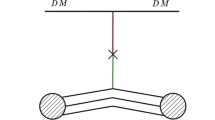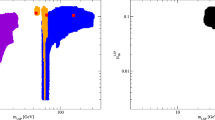Abstract
We discuss a minimal extension to the standard model in which two singlet scalar states that only interacts with the Higgs boson are added. Their masses and interaction strengths are fixed by the two requirements of canceling the one-loop quadratic corrections to the Higgs boson mass and providing a viable dark matter candidate. Direct detection of the lightest of these new states in nuclear scattering experiments is possible with a cross section within reach of future experiments.


Similar content being viewed by others
References
LEP Electroweak Working Group. arXiv:0712.0929 [hep-ex]
R. Barbieri, A. Strumia, hep-ph/0007265
R. Barbieri, A. Strumia, Phys. Lett. B 462, 144 (1999). hep-ph/9905281
G. Aad et al. (ATLAS Collaboration), Phys. Lett. B 710, 49 (2012). arXiv:1202.1408 [hep-ex]
G. Aad et al. ATLAS-CONF-2012-093
S. Chatrchyan et al. (CMS Collaboration), arXiv:1202.1488 [hep-ex]
S. Chatrchyan et al., CMS-PAS-HIG-12-020
G. Aad et al. (ATLAS Collaboration), arXiv:1109.6572 [hep-ex]
G. Aad et al., ATLAS-CONF-2011-132
S. Chatrchyan et al. (CMS Collaboration), arXiv:1109.2352 [hep-ex]
S. Chatrchyan et al., 1107.5834 [hep-ex]
S. Chatrchyan et al., CMS-PAS-HIG-11-020
N.G. Deshpande, E. Ma, Phys. Rev. D 18, 2574 (1978)
R. Barbieri, L.J. Hall, V.S. Rychkov, Phys. Rev. D 74, 015007 (2006). hep-ph/0603188
M.J.G. Veltman, Acta Phys. Pol. B 12, 437 (1981)
P. Osland, T.T. Wu, Phys. Lett. B 291, 315 (1992)
E. Ma, Phys. Rev. D 47, 2143 (1993). hep-ph/9209221
G. Ossola, A. Sirlin, Eur. Phys. J. C 31, 165 (2003). hep-ph/0305050
A. Kundu, S. Raychaudhuri, Phys. Rev. D 53, 4042 (1996). hep-ph/9410291
F. Bazzocchi, M. Fabbrichesi, P. Ullio, Phys. Rev. D 75, 056004 (2007). hep-ph/0612280
B. Grzadkowski, J. Wudka, Phys. Rev. Lett. 103, 091802 (2009). arXiv:0902.0628 [hep-ph]
A. Drozd, B. Grzadkowski, J. Wudka, J. High Energy Phys. 1204, 006 (2012). arXiv:1112.2582 [hep-ph]
N.G. Deshpande, R.J. Johnson, E. Ma, Phys. Lett. B 130, 61 (1983)
J.M. Cornwall, D.N. Levin, G. Tiktopoulos, Phys. Rev. Lett. 30, 1268 (1973). Erratum-ibid., 31, 572 (1973)
B.W. Lee, C. Quigg, H.B. Thacker, Phys. Rev. Lett. 38, 883–885 (1977)
J. McDonald, Phys. Rev. D 50, 3637 (1994). hep-ph/0702143 [hep-ph]
C.P. Burgess, M. Pospelov, T. ter Veldhuis, Nucl. Phys. B 619, 709 (2001). hep-ph/0011335
R. Dick, R.B. Mann, K.E. Wunderle, Nucl. Phys. B 805, 207 (2008). arXiv:0803.1444 [astro-ph]
C.E. Yaguna, J. Cosmol. Astropart. Phys. 0903, 003 (2009). arXiv:0810.4267 [hep-ph]
M. Srednicki, R. Watkins, K.A. Olive, Nucl. Phys. B 310, 693 (1988)
P. Gondolo, G. Gelmini, Nucl. Phys. B 360, 145 (1991)
E.W. Kolb, M.S. Turner, The Early Universe (Addison-Wesley, Reading, 1993)
M. Cirelli, N. Fornengo, A. Strumia, Nucl. Phys. B 753, 178 (2006). hep-ph/0512090
J. Beringer et al. (Particle Data Group), Phys. Rev. D 86, 010001 (2012)
M. Cirelli et al., J. Cosmol. Astropart. Phys. 1103, 051 (2011). arXiv:1012.4515
P. Ciafaloni et al., J. Cosmol. Astropart. Phys. 1103, 019 (2011). arXiv:1009.0224
R. Barbieri, M. Frigeni, G.F. Giudice, Nucl. Phys. B 313, 725 (1989)
J.R. Ellis et al., Phys. Rev. D 71, 095007 (2005). hep-ph/0502001
A. Bottino et al., Astropart. Phys. 13, 215 (2000). hep-ph/9909228
A. Bottino et al., Astropart. Phys. 18, 205 (2002). hep-ph/0111229
Acknowledgements
We thank P. Ullio and N. Fornengo for explaining to us some aspects of DM physics. MF thanks SISSA for the hospitality.
Author information
Authors and Affiliations
Corresponding author
Rights and permissions
About this article
Cite this article
Bazzocchi, F., Fabbrichesi, M. A simple inert model solves the little hierarchy problem and provides a dark matter candidate. Eur. Phys. J. C 73, 2303 (2013). https://doi.org/10.1140/epjc/s10052-013-2303-3
Received:
Published:
DOI: https://doi.org/10.1140/epjc/s10052-013-2303-3




